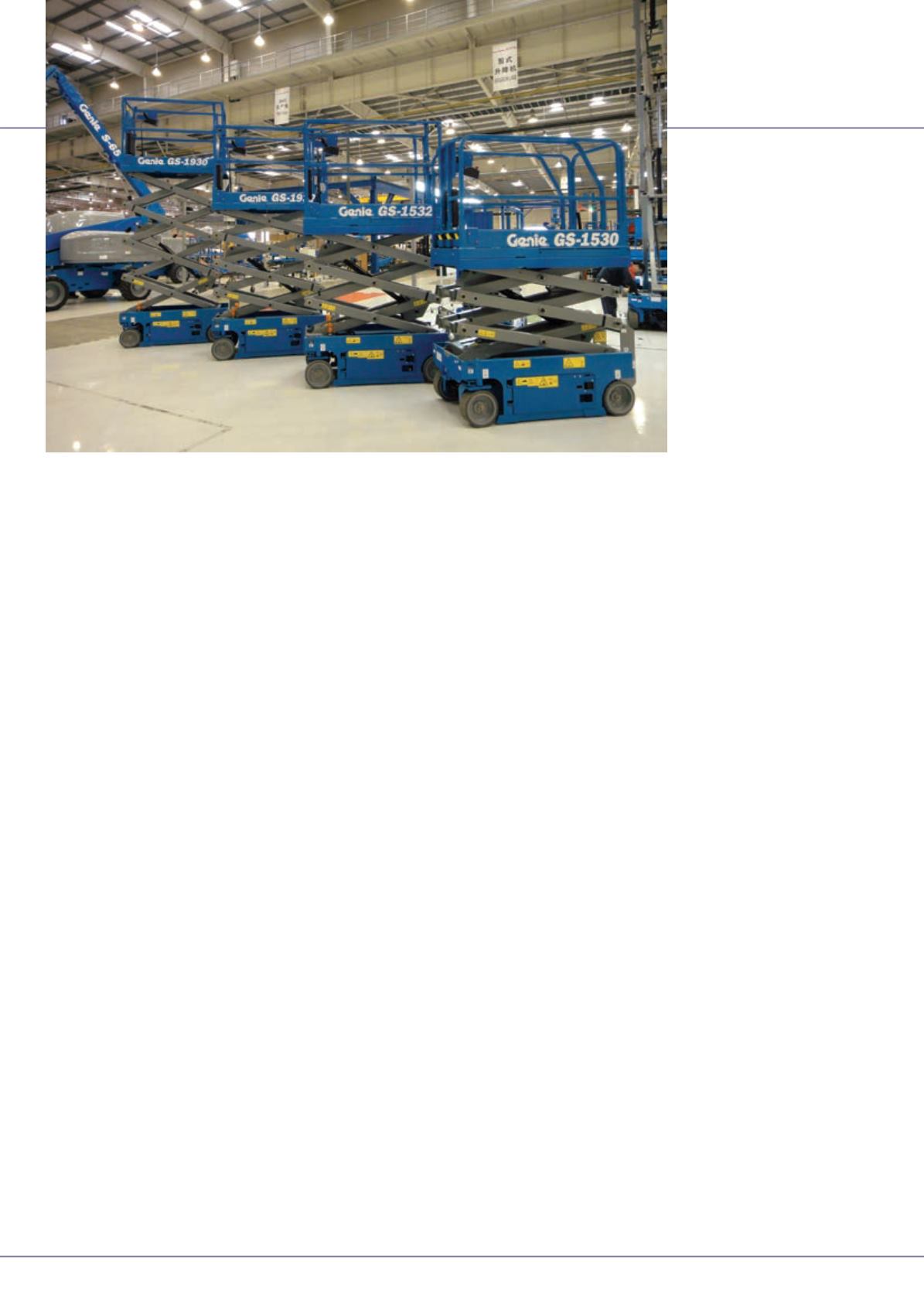
59
EQUIPMENT
july-august 2014
international
construction
TEREX
Tipping point
T
erex AWP, better known by
its brand name Genie, has
had a presence in China
since the mid-1990s. It started
out selling big telescopic boom
platforms to Chinese shipyards,
building its business up to a
point in 2010 when it opened a
dedicated access platform factory in
Changzhou.
It is a mark of how far the
business has come that today the
Changzhou factory is Genie’s global
production centre for shipyard
booms. On the regional level, it
also builds numerous other models
for sale throughout Asia-Pacific and
of course has a big focus on the
potentially huge Chinese market.
Despite a continued slow-down
in the Chinese construction
market, the ramping-up of
production for the wider region
has seen big changes over the last
year at the 278,000 ft
2
(26,000 m
2
)
facility, as general manager Clint
Weber explained.
“If you were to compare last year
to this year, we have brought in 15
models that we are building instead
of importing now,” he said. “We’ve
had good growth, but it’s not just
China. Changzhou supports Asia-
Pacific now, so it’s a much bigger
piece of the pie.”
This has seen the facility’s
workforce swell from 140 staff a
year ago to more than 210. But it
People in the powered
access industry talk
about new territories
reaching a turning
point, when suddenly
the concept takes root
and the market takes
off. Genie believes that
moment could be just
around the corner in
China.
Chris Sleight
reports.
is not just about more people on
the production side. There is also
a design capability in Changzhou,
and one of the priorities at the
moment is to localise the products
more to take out costs.
“We have a strategic plan, and
the point is that anything we do to
take cost out will be imperceptible.
We are maintaining the global
standard of our machines. If we
were to localise a component
or weld something in house, it
has to pass all the rigours of the
Genie Engineering Standards
that we have, which are difficult
to pass, rightfully so. There are
opportunities to take cost out, but
we’re not going to go to the lowest
of the low.
“It has to be imperceptible. You
won’t be able to see the difference
between our machines and those
made in Redmond (Genie’s home
facility in Washington state, US).
There might be slightly different
components, but those components
will be interchangeable. If you
have one component and it won’t
fit on another machine, then that
becomes a different machine. When
we’re exporting to Asia-Pacific and
the rest of the world, that becomes
important,” said Mr Weber.
While the Changzhou plant has
come to establish itself as Genie’s
regional hub for Asia-Pacific, the
big prize is of course China, which
Genie’s Changzhou, China factory is now making
eight scissor lifts per day, among other products.
is by far the biggest construction
equipment market in the world
in unit terms. But although
staple construction machines like
excavators and loaders sell in the
hundreds of thousands per year
in China, access platforms are far
from enjoying the same level of
acceptance.
Tipping point
It is a pattern that has been
reflected in many countries around
the world over the years, and
those close to the industry observe
that after many patient years of
introducing products and educating
the market, powered access
eventually tends to take off. This
tipping point is just around the
corner according to Jim Barr, Terex
AWP’s vice president and general
manager for Greater China.
“Obviously everybody’s waiting
for that exponential growth that
happens in new markets. In Korea
it happened in 1999, Singapore
happened in the early 1990s and
Australia happened around 1988.
There’s an inflection point and
China feels very close to that, at
least from my experience in the
marketplace,” he said.
One of the curious things about
this is that platform sales in China
are on the up at the time when
the wider construction equipment
industry is suffering a third straight
year of contraction, following the
huge stimulus-spending boom of
2009 to 2011.
Mr Barr acknowledged this. “It’s
going from strength to strength,
but at the same time we’re cautious.
A lot of the key elements in the
marketplace are there for that
inflection point. A huge project
might push it, or a change in safety
rules - which is what happened in
Brazil and Singapore. There’s going
to be something that pushes it over
the top.”
He continued, “This is my take
on the marketplace. You have
construction at the centre and
you have three key elements –
safety, availability of product and
efficiency & productivity. Right
now in China, safety is coming.
We have a reduction in scaffolding.
I don’t see it as being forced – it
seems to be organic as more aerial
work platforms become available.
Social pressure is there and the
standard of living is increasing. You
see in every emerging market that
as the standard of living improves,
people are more concerned about
safety.
“None of this will happen unless
there are affordable products in
the marketplace. Contractors need
to be able to look at projects and
say ‘I’m going to bid this based on
19 ft scissors or 32 ft scissors.’ We
have professional rental in place
>


